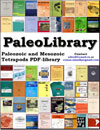
Complete Data Base of Paleozoic and Mesozoic Tetrapods.
Paleo-News and illustrations. Big electronic PDF-library.
| |
| PaleoNews |
| Classification |
| Books and Articles |
| Contact |
| Forum |
сайт о динозаврах
рейтинг сайтов
Free Counter
myspace hit counter
Revision of the enigmatic crocodyliform Elosuchus felixi de Lapparent de Broin, 2002 from the Lower–Upper Cretaceous boundary of Niger: potential evidence for an early origin of the clade Dyrosauridae |
July 22 , 2016 The enigmatic crocodyliform ‘Elosuchus’ felixi from the Echkar Formation (upper Albian to lower Cenomanian, Early–Late Cretaceous boundary) west of In Abangharit, Agadez District, Niger, is here re-described. Our assessment of the material shows that there are at least two taxa amongst the referred material: ‘E.’ felixi, including the holotype (an incomplete lower jaw) and two larger incomplete lower jaws; and an incomplete premaxilla, which we refer to Elosuchus sp. All other referred material is herein considered Crocodyliformes indeterminate. Based on our study of ‘E.’ felixi we refer it to a new genus, Fortignathus. A comparative study and updated phylogenetic analyses both suggest that F. felixi comb. nov. is a non-hyposaurine dyrosaurid or a dyrosaurid sister taxon. This is supported by four characteristics, including: inferred double festooned maxillae, a large gap between the D2 and D3 alveoli, gladius-shaped anterior dentary, and enlarged D4 alveoli that have a subrectangular cross section. The paucity of material means we refrain from referring F. felixi comb. nov. to Dyrosauridae. This species and suggestive material from the Cenomanian of Sudan allows us to formulate two hypotheses, however: (1) basal dyrosaurids were either freshwater or could live in both freshwater and saltwater ecosystems; and (2) Africa was their place of origin and dispersal. Mark T. Young, Alexander K. Hastings, Ronan Allain and Thomas J. Smith (2016)
|
